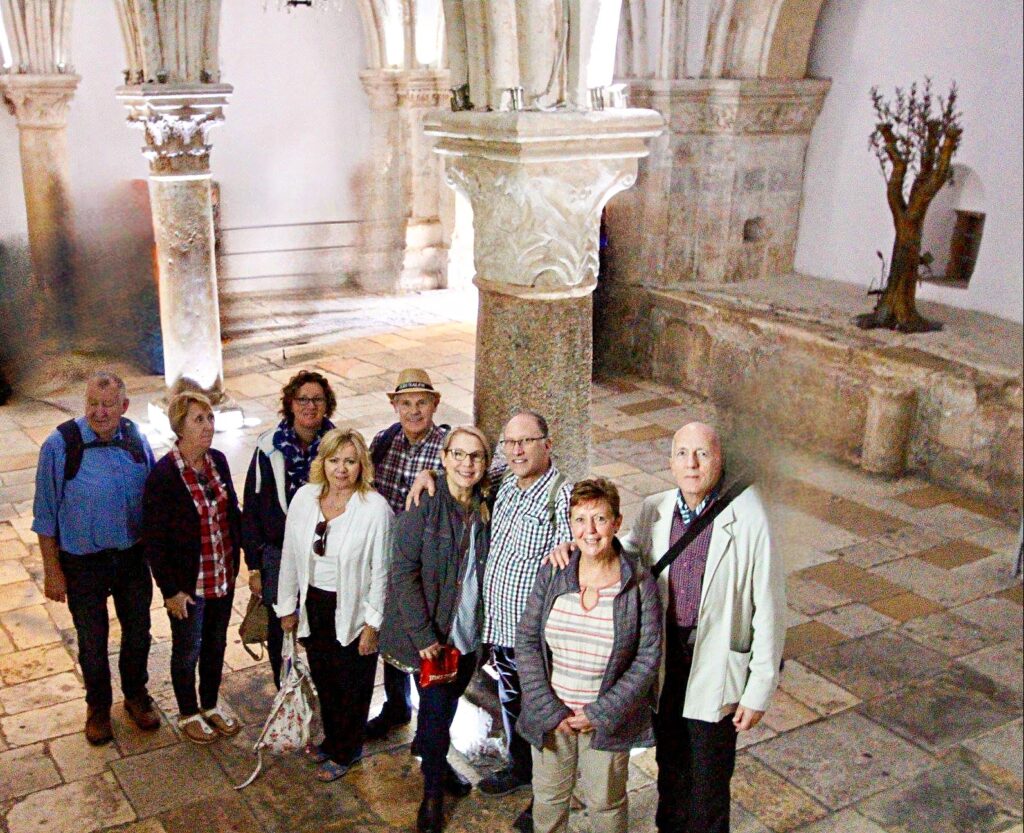
On Thursday night (beginning of Friday by the Jewish reckoning) of Holy Week, “Then came the day of unleavened bread, when the passover must be killed. And he sent Peter and John , saying, Go and prepare us the passover, that we may eat. …[in] a large upper room furnished.” Luke 22: 7-8, 12. Toward the end of the Passover meal, “Jesus took bread, and blessed it, and brake it, and gave it to the disciples, and said, Take, eat; this is my body. And he took the cup, and gave thanks, and gave it to them, saying, Drink ye all of it; For this is my blood of the new testament, which is shed for many for the remission of sins.” Matthew 26: 26-28. “And when they had sung an hymn, they went out into the mount of Olives.” Matthew 26:30. The sacrament/communion/eucharist was instituted by the Lord to his followers.
During this supper, Jesus identified Judas as the disciple who would betray him (Matthew 26:21-25). Only Jesus and the twelve disciples are mentioned at the last supper, but there may have been others. Following Jewish tradition at the time, it would have been normal for the women followers, such as mother Mary and Mary Magdalene, to have prepared the meal and be present to serve it. When the Lord and the eleven apostles left for the Garden of Gethsemane it is likely that the women stayed behind to clean up.
The hymn that the Lord and the disciples sung would have been what we now call a psalm. Some scholars have suggested it may have been one of the Hallel (“praise” in Hebrew) Psalms 113-118. Psalm 118 is particularly appropriate. Some excerpts from Psalm 118 are: “O give thanks unto the LORD; for he is good: because his mercy endureth for ever,” vs. 1. “The LORD is on my side; I will not fear: what can man do unto me?” vs. 6. “The LORD is my strength and my song, and is become my salvation,” vs. 14. “The stone which the builders refused is become the head stone of the corner. This is the LORD’s doing; it is marvellous in our eyes. This is the day which the LORD hath made; we will rejoice and be glad in it. Save now, I beseech thee, O LORD,” vs. 22-25. And, “Blessed be he that cometh in the name of the LORD: we have blessed you out of the house of the LORD,” vs. 26.

Located on Jerusalem’s Mount Zion, the Upper Room (a.k.a. Cenacle) of the Last Supper is an ancient room with marvelous acoustics. The building is dated about the 12th century AD and was part of a Latin monastery. It is of Crusader style construction.
Saint Epiphanias of Salamis wrote in about 394 AD, that at the time Emperor Hadrian visited Jerusalem (130-131 AD), there was on Mt. Zion “a small church of God. It marked the site of the Upper Room to which the disciples returned from the Mount of Olives after the Lord had been taken up (Acts 1:13-14). It had been built on that part of Sion.”1
Archaeological evidence indicates this could be the site of the Byzantine Church of the Apostles, and thus the traditional site of the Last Supper as well as the place where the Holy Ghost descended on the day of Pentecost. Additionally, under the Upper Room, on the ground floor, is the traditional site of the Tomb of King David.
- Donato Baldi, Enchiridion Locorum Sanctorum, Jerusalem: Franciscan Printing Press, 1982; reprint of the 2nd edition of 1955, no. 733 ↩︎
< Previous Post on the Triumphal Entry on Palm Sunday
Next post on Good Friday Crucifixion at Golgotha/Calvary >
Return to Homepage